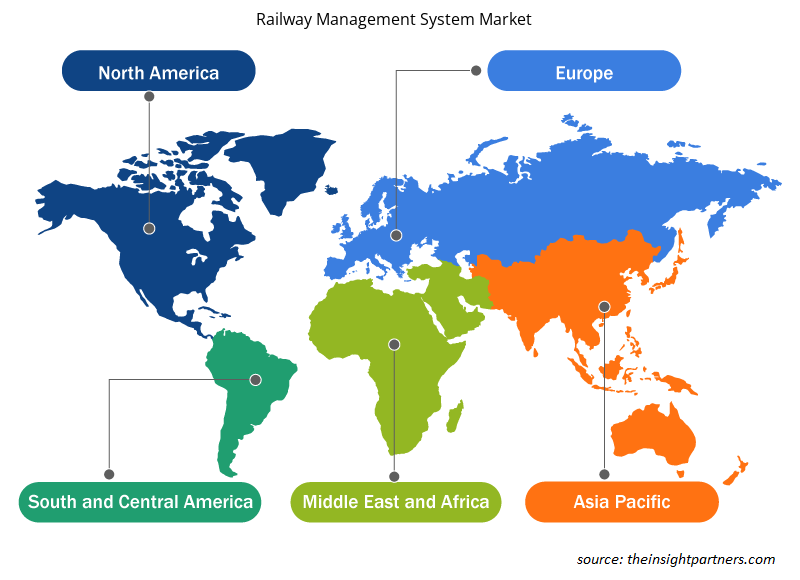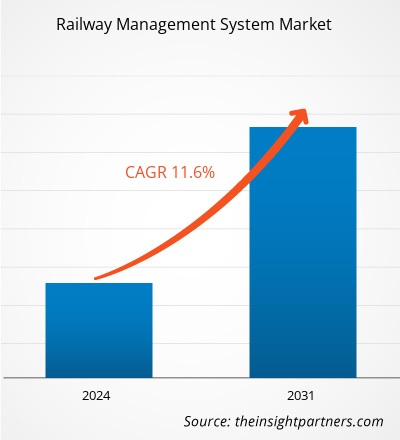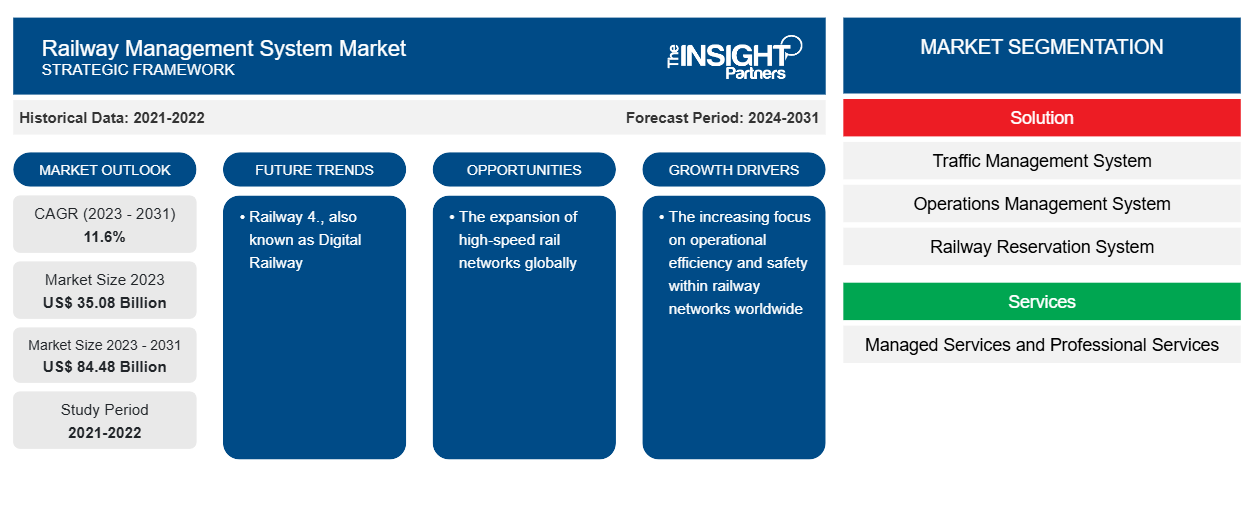鉄道管理システムの市場規模は、2023 年の 350.8 億米ドルから 2031 年には 844.8 億米ドルに達すると予測されています。市場は 2023 年から2031 年にかけて 11.6 % のCAGR を記録すると予想されています。デジタル鉄道としても知られる Railway 4.0 は、今後も鉄道管理システム市場の主要トレンドであり続けると思われます。
鉄道管理システム市場分析
鉄道管理システム市場は、インフラ開発や輸送技術のさまざまなトレンドによって成長しています。これらのシステムは、リアルタイム監視や予知保全などの機能よりも、運用効率、安全性の向上、乗客の体験に重点を置いています。市場を牽引している技術には、鉄道業務のリモート最適化と管理を可能にする AI (人工知能)、IoT (モノのインターネット)、クラウド コンピューティングなどがあります。全体として、鉄道管理システム市場は、鉄道の効率、安全性、持続可能性を向上させる必要性に駆り立てられ、世界的に成長し拡大しています。
鉄道管理システム市場の概要
鉄道管理システムには、鉄道ネットワークを効率的に管理および運用するための複数のプロセスとテクノロジーが含まれています。これには、貨物管理、発券システム、乗客情報、列車のスケジュール、保守スケジュール、安全監視などのコンポーネントが含まれます。このシステムは、GPS、通信ネットワーク、IoTセンサーなどの高度なテクノロジーを活用して、ルート計画の最適化、安全性の確保、列車のリアルタイム追跡を可能にします。乗客サービスは、座席予約、オンラインチケット予約、列車スケジュールのリアルタイム更新を通じて強化されます。さらに、予知保全技術を使用することで、保守活動が合理化され、ダウンタイムが短縮され、全体的な運用効率が向上します。
要件に合わせてレポートをカスタマイズする
このレポートの一部、国レベルの分析、Excelデータパックなど、あらゆるレポートを無料でカスタマイズできます。また、スタートアップや大学向けのお得なオファーや割引もご利用いただけます。
-
このレポートの主要な市場動向を入手してください。この無料サンプルには、市場動向から見積もりや予測に至るまでのデータ分析が含まれます。
鉄道管理システム市場の推進要因と機会
世界中の鉄道網における運用効率と安全性への関心の高まり
乗客と貨物量の増加に伴い、鉄道事業者は列車の運行スケジュール、線路の保守、ネットワーク全体のパフォーマンスを最適化するために高度な管理システムを導入しています。これらのシステムは 、 IoTセンサー、予測分析、リアルタイム監視などのテクノロジーを活用して、安全性を高め、遅延を最小限に抑え、運用コストを削減します。鉄道管理システムは、効率性と信頼性を向上させることで、高まる顧客の期待と規制基準を満たすのに役立ちます。
世界的な高速鉄道網の拡大
多くの国が高速鉄道をサポートするために鉄道インフラの近代化に投資しており、より速く、より持続可能な輸送オプションを提供しています。この傾向により、より高速で複雑な操作を管理し、さまざまな鉄道ネットワーク間でシームレスな接続を確保できる高度な鉄道管理ソリューションに対する大きな需要が生まれています。高速鉄道プロジェクトが拡大し続けるにつれて、革新的な鉄道管理システムの市場は大幅に成長する見込みです。したがって、予測期間中、世界的な高速鉄道ネットワークの拡大により、鉄道管理システム市場のプレーヤーに新たな機会がもたらされると予想されます。
鉄道管理システム市場レポートのセグメンテーション分析
鉄道管理システム市場分析の導出に貢献した主要なセグメントは、ソリューションと展開タイプです。
- ソリューションに基づいて、鉄道管理システム市場は、交通管理システム、運行管理システム、鉄道予約システム、旅客情報システム、保守管理システムなどに分類されます。
- サービスに基づいて、鉄道管理システム市場はマネージドサービスとプロフェッショナルサービスに分類されます。
- 展開タイプ別に見ると、市場はオンプレミスとクラウドに分かれています。2023年にはクラウドセグメントがより大きな市場シェアを占めました。
地域別鉄道管理システム市場シェア分析
鉄道管理システム市場レポートの地理的範囲は、主に北米、アジア太平洋、ヨーロッパ、中東およびアフリカ、南米/中南米の 5 つの地域に分かれています。収益の面では、ヨーロッパが鉄道管理システム市場で最大のシェアを占めています。ヨーロッパでは、確立された鉄道ネットワークと効率性への重点により、安全性、定時性、乗客体験を向上させる高度な管理システムの需要が高まっています。ドイツやフランスなどの国は、列車制御、信号、保守のための最先端の技術の導入をリードしています。
鉄道管理システム市場の地域別洞察
予測期間を通じて鉄道管理システム市場に影響を与える地域的な傾向と要因は、Insight Partners のアナリストによって徹底的に説明されています。このセクションでは、北米、ヨーロッパ、アジア太平洋、中東、アフリカ、南米、中米にわたる鉄道管理システム市場のセグメントと地理についても説明します。

- 鉄道管理システム市場の地域別データを入手
鉄道管理システム市場レポートの範囲
| レポート属性 | 詳細 |
|---|---|
| 2023年の市場規模 | 350.8億米ドル |
| 2031年までの市場規模 | 844.8億米ドル |
| 世界のCAGR(2023年~2031年) | 11.6% |
| 履歴データ | 2021-2022 |
| 予測期間 | 2024-2031 |
| 対象セグメント |
ソリューション別
|
| 対象地域と国 |
北米
|
| 市場リーダーと主要企業プロフィール |
|
鉄道管理システム市場のプレーヤー密度:ビジネスダイナミクスへの影響を理解する
鉄道管理システム市場は、消費者の嗜好の変化、技術の進歩、製品の利点に対する認識の高まりなどの要因により、エンドユーザーの需要が高まり、急速に成長しています。需要が高まるにつれて、企業は提供を拡大し、消費者のニーズを満たすために革新し、新たなトレンドを活用し、市場の成長をさらに促進しています。
市場プレーヤー密度とは、特定の市場または業界内で活動している企業または会社の分布を指します。これは、特定の市場スペースに、その市場規模または総市場価値に対してどれだけの競合相手 (市場プレーヤー) が存在するかを示します。
鉄道管理システム市場で事業を展開している主要企業は次のとおりです。
- ボンバルディア社
- DXCテクノロジーカンパニー
- EKEエレクトロニクス株式会社
- ゼネラル・エレクトリック・カンパニー
- 株式会社日立製作所
- ファーウェイテクノロジーズ株式会社
免責事項:上記の企業は、特定の順序でランク付けされていません。

- 鉄道管理システム市場のトップキープレーヤーの概要を入手
鉄道管理システム市場のニュースと最近の動向
鉄道管理システム市場は、主要な企業出版物、協会データ、データベースを含む一次調査と二次調査後の定性的および定量的データを収集することによって評価されます。以下は、音声および言語障害の市場と戦略の動向のリストです。
- 2023 年 8 月、レストラン向けに構築されたオールインワンのテクノロジー プラットフォームである Toast は、Toast POS (Point of Sale) と完全に統合された新製品である Toast Catering & Events のリリースを発表しました。この新製品は、レストランが大規模なケータリング注文やイベント計画をシームレスに管理するのに役立ちます。Toast Catering & Events は、カスタマイズ可能な宴会イベント注文 (BEO)、フルフィルメント ツール、リード管理機能をサポートしています。(出典: Toast、プレス リリース)
- 2021 年 6 月、世界有数のケータリング ソフトウェア プロバイダーである FoodStorm は、店舗内の顧客が単一の管理されたバックエンドを使用してケータリング、調理済み食品、デリ、ベーカリー製品を注文できる物理的なセルフサービス キオスクである FoodStorm Kiosk のリリースを発表しました。(出典: FoodStorm、プレス リリース)
鉄道管理システム市場レポートの対象範囲と成果物
「鉄道管理システム市場規模と予測(2023〜2031年)」レポートでは、以下の分野をカバーする市場の詳細な分析を提供しています。
- 対象範囲に含まれるすべての主要市場セグメントの世界、地域、国レベルでの市場規模と予測
- 市場の動向(推進要因、制約、主要な機会など)
- 今後の主な動向
- 詳細なPEST/ポーターの5つの力とSWOT分析
- 主要な市場動向、主要プレーヤー、規制、最近の市場動向を網羅した世界および地域の市場分析
- 市場集中、ヒートマップ分析、主要プレーヤー、最近の動向を網羅した業界の状況と競争分析
- 詳細な企業プロフィール
- 過去2年間の分析、基準年、CAGRによる予測(7年間)
- PEST分析とSWOT分析
- 市場規模価値/数量 - 世界、地域、国
- 業界と競争環境
- Excel データセット
最新レポート
関連レポート
お客様の声
購入理由
- 情報に基づいた意思決定
- 市場動向の理解
- 競合分析
- 顧客インサイト
- 市場予測
- リスク軽減
- 戦略計画
- 投資の正当性
- 新興市場の特定
- マーケティング戦略の強化
- 業務効率の向上
- 規制動向への対応























 無料サンプルを入手 - 鉄道管理システム市場
無料サンプルを入手 - 鉄道管理システム市場